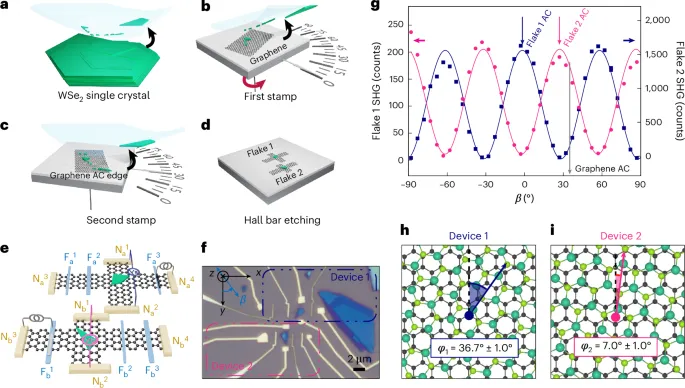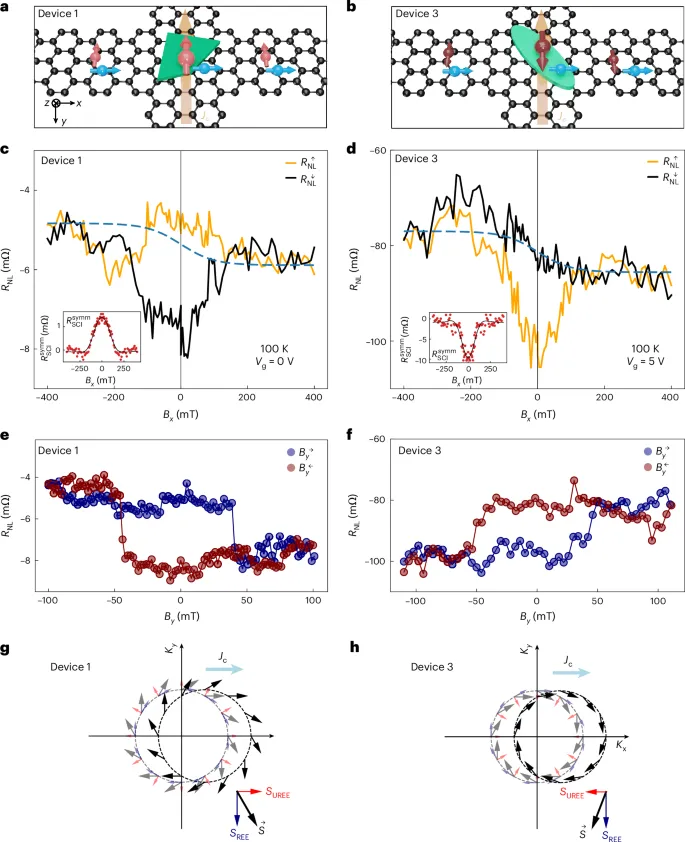Nature Materials | New Discovery in Spin-Charge Conversion in WSe₂/Graphene Heterostructures!
Research Background
Twist engineering is a powerful approach to control electronic properties in van der Waals heterostructures, making it a significant research area as it can influence various quantum properties like electron and spin behavior. Although theoretical studies have long predicted that twist angles can tune spin structures and spin-charge conversion (SCI) effects in graphene-based heterostructures, experimental studies are limited, leaving a gap between theory and practice.
Research Focus
Addressing this gap, Haozhe Yang from Beihang University, in collaboration with Félix Casanova from the Basque Science Foundation, published a study in Nature Materials titled “Twist-angle-tunable spin texture in WSe2/graphene van der Waals heterostructures.” The researchers investigated WSe2/graphene heterostructures, examining how twist angle control impacts spin structure and SCI effects.
Using optical second harmonic generation (SHG) and Raman spectroscopy to accurately measure twist angles, and conducting nonlocal spin-precession experiments, they experimentally verified for the first time that spin texture can be tuned through twist angles. This finding demonstrates the emergence of a radial spin component and its reversibility. The results suggest that twist angles can open or close radial spin components and even reverse their direction, enabling complete control over spin helicity. This discovery provides new insights and technical paths for the development of twist-angle-based spintronic devices.
Visual Breakdown
- Spin Texture Control: The study demonstrates, for the first time, that twist angles in WSe2/graphene heterostructures can directly tune spin helicity through spin-precession experiments. By adjusting the twist angle between the graphene and WSe2 layers, the researchers showcase changes in SCI.
- Observing Radial Spin Components: Nonlocal spin-precession measurements revealed both conventional Rashba-Edelstein effects (REE) and unconventional Rashba-Edelstein effects (UREE). Radial spin components emerged at different twist angles, reaching a maximum near the charge neutrality point (CNP). These results show that twist-angle adjustments can precisely control spin helicity, open or close radial spin components, and even reverse the UREE sign.

-
- Fig. 1 | Device Overview and Moiré Pattern from SHG.

- Fig. 2 | In-Plane Nonlocal Spin-Precession Measurements of REE and UREE at Various Twist Angles.

- Fig. 3 | Out-of-Plane Nonlocal Spin-Precession and Gate Dependence of SCI.

- Fig. 4 | Spin Helicity Changes with Twist Angle.

- Fig. 5 | Rashba Angle Tuning by Twist Angle.
Conclusion and Outlook
This study experimentally verifies the capability of twist angles to regulate spin textures in WSe2/graphene heterostructures, a finding with vital implications for future spintronic device design. The researchers demonstrated that changing twist angles significantly impacts SCI properties, introducing new spin components via Rashba angle modulation. This research not only reveals the mechanism for controlling spin helicity but also illustrates how to achieve this control at room temperature. This tunable spin texture feature enables switching of radial spin components and even reverses their direction, presenting new avenues for developing twist-angle-based spintronic devices. In the future, these phenomena could enhance high-performance spintronic devices, advance new spin control technologies, and expand applications in spintronics and moiré heterostructures.
Published in Nature Materials
Read the full article
Disclaimer | Some materials sourced from the web. Please leave comments for any omissions or errors due to limited expertise. For copyright issues, contact us for resolution.

